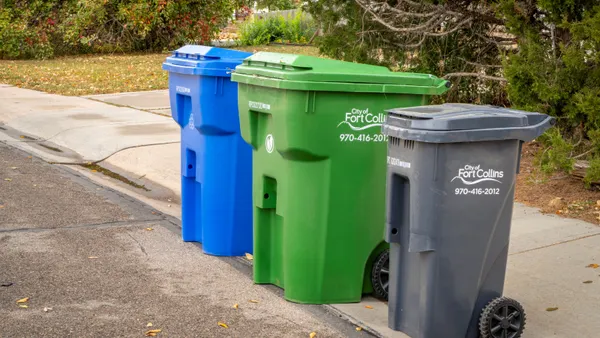Dive Brief:
- The Polymark Consortium has developed chemical markers that can help identify food-contact PET (polyethylene terephthalate) for the purpose of sorting it in the plastics waste stream. The Consortium is a three-year research project by collaborators including Petcore Europe, the United Kingdom Health and Environmental Research Institute and 4PET Recycling, and funded by the European Commission.
- The group used "near UV-excitable markers with strong fluorescence in the visible region of the electromagnetic spectrum," then developed high-speed detection technology. The markers were used in a water-based, sprayable coating. The markers can be removed after sorting.
- The group published its preliminary technical results, which will reportedly "help the recycling industry to more effectively distinguish between food-contact and non-food contact PET while meeting (European Union) regulation on the use of recycled PET for food-contact applications. The technology can also be used for other purposes," the group said in a press release. PET is commonly recycled in Europe, but sorting food-contact PET from other types in the waste stream would raise the potential for manufacturers to use more rPET (recycled PET).
Dive Insight:
This new technology has interesting applications in the industry. Patrick Peuch from Petcore Europe said in a statement, "By publicly releasing these results ... we aim to raise early awareness and to give unconstrained access to the widest number of interested parties for their faster consideration and longer-term planning."
The European market has lots of potential for growth in the plastics recycling industry. A recent market study predicts up to 300 new plastics recycling plants in Europe by 2025.
PET trade association Petcore Europe reported that 1.7 million metric tons of PET containers were collected in 2014, up 6.8% from 2013 and representing 57% of the plastic packaging placed on the market that year. PET demand also increased in 2014 by 4.8% by weight.
More resources must be invested in PET recycling. Despite high numbers of PET bottles being collected, the PET recycling industry operating rate dropped from 83% in 2013 to 79% in 2014, according to Resource. Petcore cited pricing "and pressure from low virgin PET resin prices that occurred in the last quarter of the year" for the drop.
Low levels of commodity recycling have been an economic issue in the U.S. market, as well, therefore this research can be applied to improve future operations in America.








